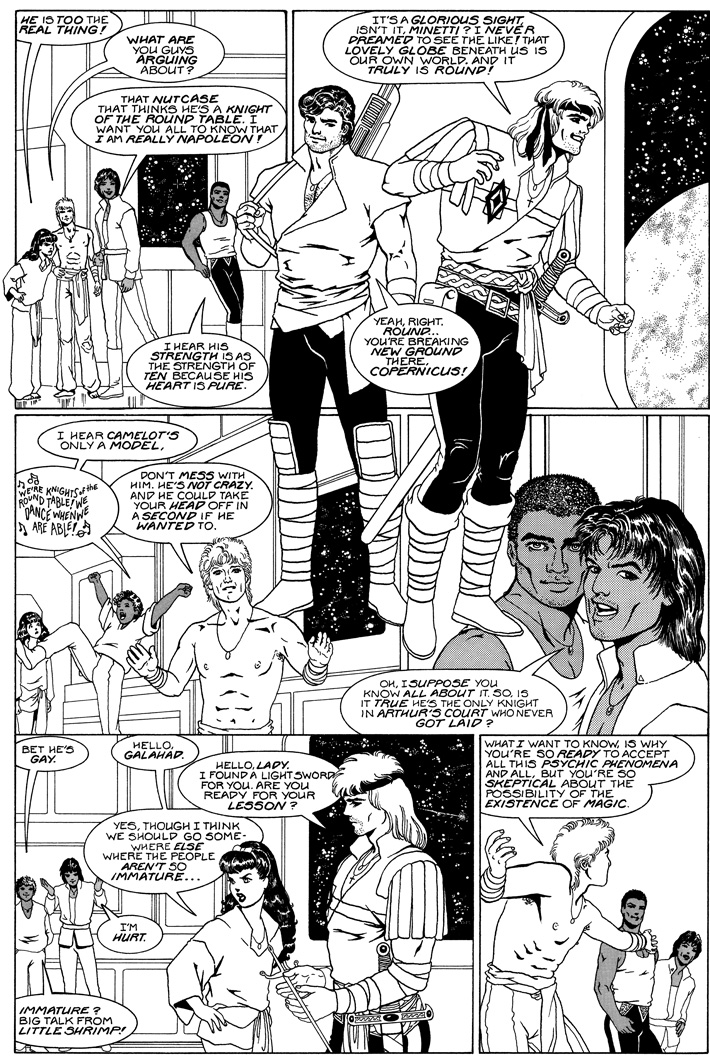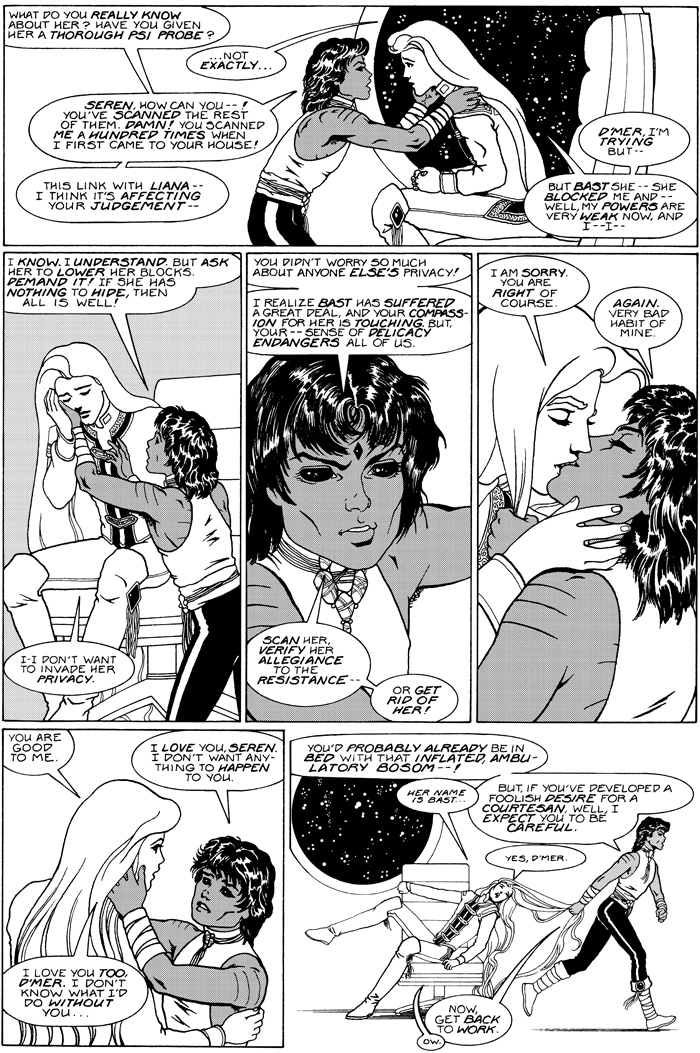
A DISTANT SOIL: The Ascendant Chapter 3 Page 13
Shot from the original art. I didn’t have enough Photoshop skills to do clean up and restoration on the early pages I posted, but now I do. It takes at least an hour per page to fix mistakes and remove flaws. This is one of the reasons I am considering cutting back to posting 3 pages a week: I need to spend more time doing NEW pages.
This page was especially problematic, with word balloon pointer mistakes and line segments missing. I had to restore parts of the background and do some work on the figures.
Fortunately, the site is bringing in more money. If that continues, I will be able to afford to spend more time on new work. And I am finishing up a side gig by tomorrow, so I’ll have a few more hours back in my week.
That said, I am enjoying the restoration process, and have learned many new skills. I can now understand why many artists give up – or never learn how – to do art by hand. Computer graphics are 1,347,689 times easier. No, really. I did the math.
And speaking of doing the math, I did the math on the digital work I am putting in on these pages. It will take 5.5 months of 40 hour work weeks to complete the restoration.
Fortunately, later pages are cleaner and will probably not take more than about 20 minutes per page to clean up. However, some of the earlier pages can take two hours or more each. So the average effort per page is 1 hour.
Whew.


13 Comments
Colleen
Further annotation.
Chris quotes Tennyson’s poem “Sir Galahad”: his strength is “as the strength of ten because his heart is pure.”
Reynaldo’s cracks about Camelot and the song he sings are from “Monty Python and the Holy Grail”.
I feel like I have to point that out for the ten people who don’t get it.
Arlnee
if it will produce more pages of new art, I vote for 3x a week posting. That seems to be a good regular schedule, most of the comics I read online do a MWF post schedule.
And most of those are creating new content 3x a week. Keeping at 5x a week you’re going to burn through what cushion you have. So yeah, might be a good idea.
Colleen
I was reading Scott Saavedra’s blog and he posted his meticulous record-keeping data for his webcomic.
While I know I have earned back all of my out of pocket, I can’t possibly have earned out paying for my time.
Starting January 1, I will be keeping detailed records of every minute I put into this. I have been struggling to find those extra hours to move forward, and have even cut way back on blogging. But there’s just no time to produce new work. And I am going to have to keep a strict eye on where that is going.
Cutting back to three times a week won’t buy much time, but between cutting back on blogging and those extra two hours, I bet I buy myself a good 8 hours a week. That’s 52 NEW pages a year, working only part time.
And even as I write about cutting back on blogging, I will post those links to Saavedra’s blog when I get a chance.
Colleen
Dang. I just realized I cut off a small portion of Liana’s figure in panel one. Looks like I did that on the original scan. I’ll have to see if I can find the original art. I should be able to drop in the missing portion without redoing the whole page.
Jan
It’s said that art is never completed, only abandoned. As a purely selfish reader, I vote for only correcting really egregious errors and sticking to 5 days. I miss new installments on weekends.
Colleen
I have to archive the book, not just to post it online BUT to convert all 1,000 pages to digital format. I have NO CHOICE but to do this. MANY printers won’t even work from negatives anymore.
Because hundreds of pages of original art are no longer in my possession, this means I am working from printed copies of the book.
Tone sheets often scan very badly. When converted to scan, they can completely blot out entire figures. There are many specs and marks on them, and on some pages you can’t even see the character’s faces.
This is not just me being nitpicky over commas. These pages must be archived to print the book.
If you don’t want future editions of the book with figures you can’t even see, I need to do this restoration.
Fixing grammatical errors is the easy part. Seriously, it’s usually only about 10 minutes per page. Correcting parts of pictures that simply fell of the page, or badly rendered tones: not so simple.
Sloppiness is tolerated in a webcomic, but unforgiveable in a printed book.
Jan
That makes sense. Thanks for explaining.
‘Nother question from the non-artist: What are the tone sheets you refer to fairly frequently?
Thanks and Happy New Year!
Colleen
I will post something more extensive to explain later, but look at the picture. See those grey areas?
Those aren’t grey. That’s an illusion.
Before computer graphics, in order to get grey onto a black and white line art page, you had to use tone sheets.
If you look very carefully at those toned areas, you will see they are composed of tiny dots. Those tiny dots print cleanly and perfectly using the old photographic printing methods.
The tiny dots are printed on transparent plastic sheets. You cut out each spot you need and the adhesive backing on the sheets sticks to your original art.
Naturally, almost no one uses this method anymore, they use computer tones, which are often not as crisp and attractive, IMHO.
Anyway, when these pages are printed at smaller than the size of the original art, the tiny dots close up and create an optical illusion of true grey.
However, because they are not true grey, there re problems when scanning them from a printed copy.
The tiny dots can create an ugly moire pattern, and get so tight together that you no longer get a clean grey. The image can even turn black.
Also, if there is any dust underneath the sheet, or even a scratch, the old printing methods might not see that, but the computer surely will. You need to go in, blow up the image very large, and pick out the flaws from the tones.
I’ve got one page where the adhesive sort of gummed up under the sheet, and has badly botched a shot of Brent’s face.
Now it might seem daft to use these sheets at all, but a lot of the computer tones don’t look as good. They are flawless when printed, but they have an unattractive airbrushed look. The mechanical sheets, if clean and shot at a high resolution, print beautifully.
Miki
Did you forget to put up the ‘Vote for my site banner’?
Colleen
Oops. Go back a day, it’s right there.
Allan
And back in the day buying tone sheets was a right rigmarole — you’d have to stand at a counter thumbing your way through a catalogue of samples, convey the reference number to the assistant, and he’d go and pick the sheet out from a huge rack of numbered drawers. Repeat ad nauseum while fighting with fellow artists who also wanted a look at the single available catalogue…
Colleen
I bought almost every sheet I own in 1996 in Japan. They were dead cheap, and came in a wide variety. Tone sheets were so common there that they sold them in art supply stores and in almost every comic shop.
Not so much anymore. Lots of artists going digital.
The Japanese sheets were very good quality. American sheets tend to yellow and get brittle with age.
I still have a foot high stack of sheets and hope it is enough to make it to the last page of ADS. That will be the last time I use them.
I was just remembering I bought well over 100 sheets in Japan my first trip and my luggage was WAY heavy. Back in the day before huge penalties for heavy luggage. Each bag was about 75 lbs!
Colleen Doran
UPDATED